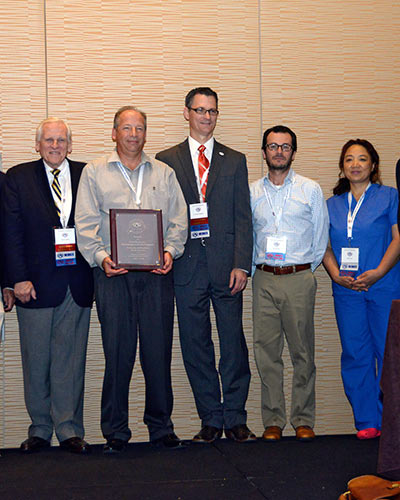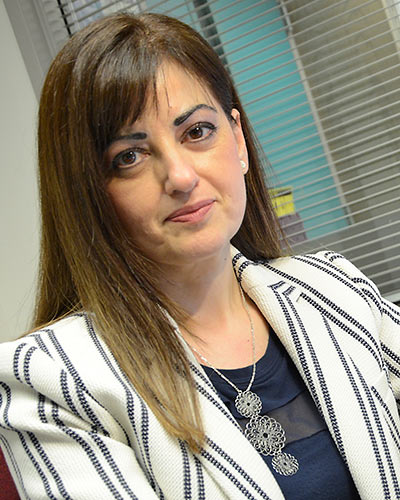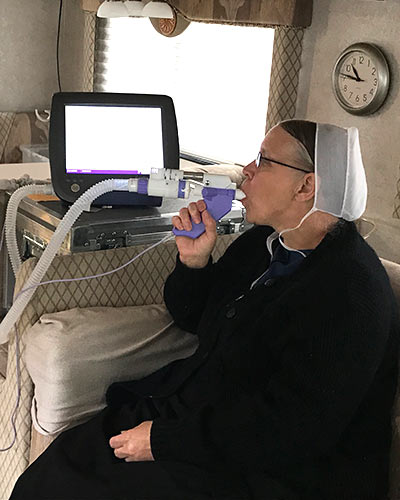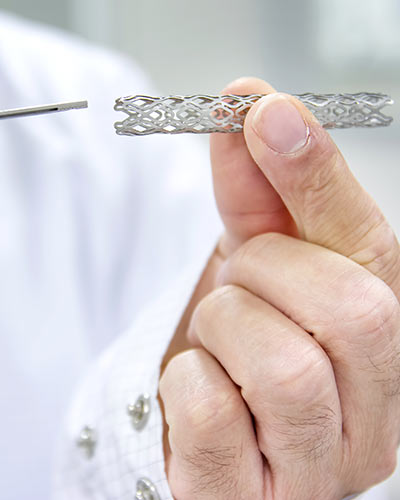September 11, 2017 | Davis Kohn

University of Maryland School of Medicine Studies Heart Patients with Impaired Breathing
Researchers at the University of Maryland School of Medicine (UM SOM) have found that a new, collaborative treatment model for seriously ill heart patients with breathing difficulties results in better care and lower costs.
The first-ever study, published in the Journal of the American College of Cardiology, examined the use of medical specialists in intensive care (known as intensivists) for patients receiving mechanical breathing assistance in the Cardiac Intensive Care Unit (CICU) at the University of Maryland Medical Center (UMMC).
The researchers found that using intensivists to help treat these patients improved their care, decreased the amount of time the patients stayed in the hospital, and lowered costs.
"When we looked at the clinical results of our intervention, we were removing the breathing tube faster, and getting patients out of the Cardiac ICU about two days earlier than previously," says study senior author Michael T. McCurdy, MD, FCCM, FCCP, FAAEM, associate professor of pulmonary & critical care medicine and emergency medicine at UM SOM. "Plus, we saved well over $4 million a year in hospital costs. It was striking."
Intensivists specialize in the care of critically ill or injured patients. At UMMC, the intensivists have additional expertise in pulmonary medicine and the use of mechanical ventilators. Prior to the intensivist consultations, cardiologists were responsible for monitoring and weaning patients from mechanical ventilators in the CICU.
"This is a developing paradigm – critical care medicine-trained physicians working collaboratively with cardiologists in a CICU," says study co-author Gautam V. Ramani, MD, assistant professor of medicine at UM SOM and medical director of clinical advanced heart failure at UMMC. "The take-home message: there is a role for a collaborative model between critical care and cardiac care."
UMMC's adult cardiac ICU has 15 beds serving about 2,000 patients annually, with a variety of cardiac abnormalities and conditions: heart attack, pre- and post-heart transplantation management, drug and mechanical circulatory support and treatment of pulmonary hypertension.
 Study Details
Study Details
The study looked at data from a year before and after the intensivist consultations were started. A total of 363 patients receiving mechanical ventilation in the CICU were included: 162 in the pre-implementation group and 201 in the post-implementation group.
The researchers analyzed how long patients were in the hospital, assessed whether patients met a benchmark of 28 days of unassisted breathing, calculated costs associated with both length of stay and total hospitalization, and recorded in-hospital death rates.
A key finding underscores direct benefits to patients, says Dr. McCurdy, "The number of patients discharged to home from the CICU rose significantly, from 27 percent to 42 percent."
Dr. Ramani says the next stage could be to use physicians trained in both cardiology and critical care medicine: "It's difficult to find these people. It's a new area, a new field. Not many people have dual certification, but there is increasing recognition that this collaborative approach can reduce the length of stay and improve patient outcomes."
"The improvements in patient care alone warrant further study of this collaborative staffing model," says E. Albert Reece, MD, PhD, MBA, vice president of medical affairs at the University of Maryland and dean of the School of Medicine. "Likewise, at a time when we are all striving for prudent and efficient stewardship of scarce medical care resources, expanded application of this model and a review of efforts to cross-train intensive care physicians are worthwhile pursuits."
Breathing difficulties are a common aspect of certain types of heart disease. According to the American Heart Association, shortness of breath and persistent coughing or wheezing can be a sign of heart failure, in which the heart can't pump enough blood to meet the body's needs.
About the University of Maryland School of Medicine
Commemorating its 210th Anniversary, the University of Maryland School of Medicine was chartered in 1807 as the first public medical school in the United States. It continues today as one of the fastest growing, top-tier biomedical research enterprises in the world -- with 43 academic departments, centers, institutes, and programs; and a faculty of more than 3,000 physicians, scientists, and allied health professionals, including members of the National Academy of Sciences, and a distinguished recipient of the Albert E. Lasker Award in Medical Research. With an operating budget of more than $1 billion, the School of Medicine works closely in partnership with the University of Maryland Medical Center and Medical System to provide research-intensive, academic and clinically-based care for more than 1.2 million patients each year. The School has over 2,500 students, residents, and fellows, and nearly $450 million in extramural funding, with more than half of its academic departments ranked in the top 20 among all public medical schools in the nation in research funding. As one of the seven professional schools that make up the University of Maryland, Baltimore campus, the School of Medicine has a total workforce of nearly 7,000 individuals. The combined School and Medical System (“University of Maryland Medicine”) has a total budget of $5 billion and an economic impact of nearly $15 billion on the state and local community. The School of Medicine faculty, which ranks as the 8th-highest public medical school in research productivity, is an innovator in translational medicine with 600 active patents and 24 start-up companies. The School works locally, nationally, and globally, with research and treatment facilities in 36 countries around the world. Visit medschool.umaryland.edu/
About the University of Maryland Medical Center
The University of Maryland Medical Center (UMMC) is comprised of two hospitals in Baltimore: an 800-bed teaching hospital – the flagship institution of the 12-hospital University of Maryland Medical System (UMMS) – and a 200-bed community teaching hospital, UMMC Midtown Campus. UMMC is a national and regional referral center for trauma, cancer care, neurocare, cardiac care, diabetes and endocrinology, women’s and children’s health, and has one of the largest solid organ transplant programs in the country. All physicians on staff at the flagship hospital are faculty physicians of the University of Maryland School of Medicine. At UMMC Midtown Campus, faculty physicians work alongside community physicians to provide patients with the highest quality care. UMMC Midtown Campus was founded in 1881 and is located one mile away from the University Campus hospital. For more information, visit www.umm.edu.
Learn More
• Pulmonary and Critical Care Medicine
• Department of Emergency Medicine
Contact
Office of Public Affairs
655 West Baltimore Street
Bressler Research Building 14-002
Baltimore, Maryland 21201-1559
Contact Media Relations
(410) 706-5260
Related stories

Friday, December 15, 2023
UMSOM Researchers Discover First Ever Link Between Hemoglobin-Like Protein and Normal Cardiac Development
In a landmark study led by the University of Maryland School of Medicine, researchers discovered for the first time that a certain kind of protein similar to hemoglobin, called cytoglobin, plays an important role in the development of the heart. Specifically, it affects the correct left-right pattern of the heart and other asymmetric organs. The findings, published today in the journal Nature Communications, could eventually lead to the development of new therapeutic interventions to alter the processes that lead to these defects.

Tuesday, September 26, 2017
University of Maryland Medicine Receives Prestigious Award For Its Heart and Lung Resuscitation Program
A heart and lung resuscitation program at University of Maryland Medicine (UMM) has been recognized for its elite level of care by a leading group in the field.

Wednesday, June 07, 2017
University of Maryland School of Medicine Researchers Identify Gene That May Play a Central Role in Heart Disease
Heart disease kills more than 600,000 Americans every year, which translates to more than one in every four deaths. Although lifestyle choices contribute to the disease, genetics play a major role. This genetic facet has remained largely mysterious. But new research by scientists at the University of Maryland School of Medicine (UM SOM) has identified what may be a key player: a mutated gene that leads to irregular heartbeat, which can lead to a dangerously inefficient heart.

Friday, May 05, 2017
Secondhand Smoke Ups Heart Disease in Unique Group of Female Nonsmokers – Amish Women
New research at the University of Maryland School of Medicine (UM SOM) has found that secondhand smoke tends to have somewhat different effects on men and women. The research, conducted in a Pennsylvania Amish community where virtually no women smoke, found that women who were exposed to secondhand smoke had a greater risk for cardiovascular disease, while men exposed to secondhand smoke tended to have a higher body mass index (BMI).

Wednesday, January 11, 2017
University of Maryland Medical Center Offers Genetic Testing as Standard of Care to Help Improve Outcomes for Heart Stent Patients
The University of Maryland Medical Center (UMMC) is now offering a simple genetic test to patients who receive heart stents to determine whether they have a genetic deficiency that affects how they respond to a common drug to prevent blood clots. Patients are typically given the medication, clopidogrel, to prevent cardiovascular events after having a stent placed in a coronary artery to treat a blockage.

Tuesday, December 20, 2016
First U.S. Babies Treated in Unique Study of Adult Stem Cell Therapy for Congenital Heart Disease
In a first-in-children randomized clinical study, medical researchers at the University of Maryland School of Medicine (UM SOM) and the Interdisciplinary Stem Cell Institute (ISCI) at the University of Miami Miller School of Medicine have begun testing to see whether adult stem cells derived from bone marrow benefit children with the congenital heart defect hypoplastic left heart syndrome (HLHS).
